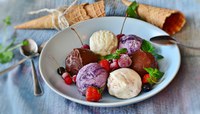Prairie Fare: A scoop of summer – Frozen favorites, past and present
(Click an image below to view a high-resolution image that can be downloaded)
“We used to eat sherbet out of toilet paper tubes,” someone commented on social media recently.
I chuckled at the memory. Of course, we didn’t actually eat from toilet paper tubes, but the waxed, tubular packaging made it easy to push up the frozen treat inside. Some stores still carry those nostalgic tubes of sherbet.
I remember when popsicles weren’t fully wrapped. You guessed the flavor by the color peeking through the bottom of the wrapper. Back then, you could get a treat for just a dime. That pricing officially makes me a relic.
The flavored ice pops we froze at home were even cheaper — I always ended up with a cherry-red stain on my shirt from squeezing out every drop of flavored ice.
Ice cream is a favorite for many. July is National Ice Cream Month, a designation from former President Ronald Reagan.
Frozen desserts are hardly new. Thousands of years ago, people used snow and fruit juice to craft early versions of these cool treats, according to food historians. Today, our options are endless.
Frozen novelties — ice cream bars, drumsticks, popsicles — remain very popular. But not everyone can enjoy dairy-based products. Plant-based options like soy- or oat-based ice creams have become more widely available, especially for people with dietary issues or those following a vegetarian diet.
Have you tried frozen yogurt, sorbet, sherbet or gelato? When shopping, always check the Nutrition Facts label and ingredient list. A product containing milk will be noted at the end of the ingredient statement (e.g., “contains milk”).
Here’s a quick guide to several popular frozen treats:
- Ice cream must contain at least 10% milk fat, making it rich and creamy. Creative flavors are widely available, including black raspberry, pumpkin, coffee, cake batter or cotton candy. Nationally, vanilla, chocolate or cookies and cream are top picks. Frozen custard contains pasteurized egg yolks (1.4% by weight) in the formulation to lend richness.
- Sherbet contains less than 2% dairy by weight.
- Frozen yogurt contains dairy and live cultures, usually with a slightly tangy flavor and less fat than traditional ice cream.
- Gelato has less cream and more milk than ice cream, resulting in a denser, smoother product with a softer texture.
- Sorbet contains no dairy — just fruit, water and sweetener.
Have you ever opened a container of ice cream only to find it icy or grainy? That’s a sign your freezer may not be cold enough or you left it out too long. Keep freezers at 0 degrees Fahrenheit or lower to ensure quality. Melting and refreezing encourage the formation of ice crystals and the sandy-textured ice cream that no one enjoys.
For best results, scoop and return it to the freezer immediately. Some people place a layer of parchment paper on top of the ice cream and store the container upside down to reduce freezer burn.
And what about that dreaded “brain freeze”? Slow down and keep the frozen treat toward the front of your mouth so it can warm slightly before swallowing. Letting it touch the roof of your mouth stimulates the trigeminal nerve, triggering that brief but intense pain.
Are you ready to make a frozen treat? Here’s a simple recipe that uses seasonal fruit and no fancy equipment.
Melon Raspberry Sorbet
3 cups ripe melon*, cubed and frozen
1 cup frozen raspberries
2 tablespoons honey, or to taste
Juice of one lime or lemon
½ to 1 cup warm water, as needed, to help blend
Optional: Add or top with fresh mint leaves to add a refreshing, minty flavor.
At least 5 hours before you would like to make the sorbet, peel and cut the melon into ½-inch cubes and place on a sheet pan lined with parchment paper. Place the pan in the freezer. Freeze for 5 hours or overnight. Add frozen melon, frozen raspberries, honey and lime/lemon juice to a blender or food processor. Blend until smooth, adding warm water as needed to aid in blending.
*Any melon can be used in this recipe, but cantaloupe or honeydew provides the creamiest consistency.
Makes three 1 1/2-cup servings. One serving has 123 calories, 0 grams (g) fat, 2 g protein, 31 g carbohydrate, 4 g fiber and 28 milligrams sodium.
(Julie Garden-Robinson, Ph.D., R.D., L.R.D., is a North Dakota State University Extension food and nutrition specialist and professor in the Department of Health, Nutrition and Exercise Sciences.)
NDSU Agriculture Communication – July 3, 2025
Source: Julie Garden-Robinson, 701-231-7187, julie.garden-robinson@ndsu.edu
Editor: Dominic Erickson, 701-231-5546, dominic.erickson@ndsu.edu




